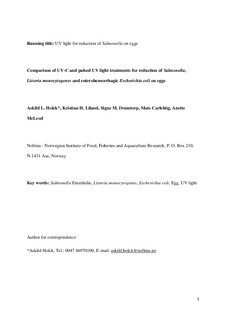| dc.contributor.author | Holck, Askild Lorentz | |
| dc.contributor.author | Liland, Kristian Hovde | |
| dc.contributor.author | Drømtorp, Signe Marie | |
| dc.contributor.author | Carlehög, Mats | |
| dc.contributor.author | McLeod, Anette | |
| dc.date.accessioned | 2018-02-07T08:28:28Z | |
| dc.date.available | 2018-02-07T08:28:28Z | |
| dc.date.created | 2018-01-03T12:45:16Z | |
| dc.date.issued | 2018 | |
| dc.identifier.citation | Journal of Food Protection. 2018, 81 (1), 6-16. | nb_NO |
| dc.identifier.issn | 0362-028X | |
| dc.identifier.uri | http://hdl.handle.net/11250/2483138 | |
| dc.description.abstract | Ten percent of all strong-evidence foodborne outbreaks in the European Union are caused by Salmonella related to eggs and egg products. UV light may be used to decontaminate egg surfaces and reduce the risk of human salmonellosis infections. The efficiency of continuous UV-C (254 nm) and pulsed UV light for reducing the viability of Salmonella Enteritidis, Listeria monocytogenes, and enterohemorrhagic Escherichia coli on eggs was thoroughly compared. Bacterial cells were exposed to UVC light at fluences from 0.05 to 3.0 J/cm2 (10 mW/cm2, for 5 to 300 s) and pulsed UV light at fluences from 1.25 to 18.0 J/cm2, resulting in reductions ranging from 1.6 to 3.8 log, depending on conditions used. Using UV-C light, it was possible to achieve higher reductions at lower fluences compared with pulsed UV light. When Salmonella was stacked on a small area or shielded in feces, the pulsed UV light seemed to have a higher penetration capacity and gave higher bacterial reductions. Microscopy imaging and attempts to contaminate the interior of the eggs with Salmonella through the eggshell demonstrated that the integrity of the eggshell was maintained after UV light treatments. Only minor sensory changes were reported by panelists when the highest UV doses were used. UV-C and pulsed UV light treatments appear to be useful decontamination technologies that can be implemented in continuous processing. | |
| dc.language.iso | eng | nb_NO |
| dc.title | Comparison of UV-C and Pulsed UV Light Treatments for Reduction of Salmonella, Listeria monocytogenes, and Enterohemorrhagic Escherichia coli on Eggs | nb_NO |
| dc.type | Journal article | nb_NO |
| dc.type | Peer reviewed | nb_NO |
| dc.description.version | submittedVersion | |
| dc.source.pagenumber | 6-16 | nb_NO |
| dc.source.volume | 81 | nb_NO |
| dc.source.journal | Journal of Food Protection | nb_NO |
| dc.source.issue | 1 | nb_NO |
| dc.identifier.doi | 10.4315/0362-028X.JFP-17-128 | |
| dc.identifier.cristin | 1534755 | |
| dc.relation.project | Norges forskningsråd: 221663 | nb_NO |
| dc.relation.project | Nofima AS: 10333 | nb_NO |
| dc.relation.project | Nofima AS: 201704 | nb_NO |
| dc.relation.project | Norges forskningsråd: 262306 | nb_NO |
| dc.relation.project | Nofima AS: 11055 | nb_NO |
| cristin.unitcode | 7543,3,4,0 | |
| cristin.unitcode | 7543,3,2,0 | |
| cristin.unitcode | 7543,3,3,0 | |
| cristin.unitname | Trygg og holdbar mat | |
| cristin.unitname | Råvare og prosess | |
| cristin.unitname | Sensorikk, forbruker og innovasjon | |
| cristin.ispublished | true | |
| cristin.fulltext | preprint | |
| cristin.qualitycode | 1 | |
